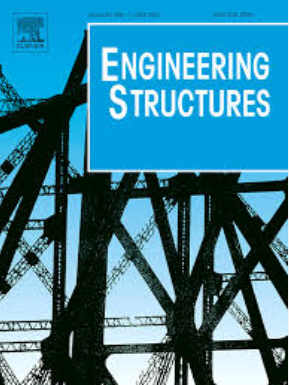Revealing critical failure laws of composite curved beams through network-free renormalization and clustering algorithm
IF 5.6
1区 工程技术
Q1 ENGINEERING, CIVIL
引用次数: 0
Abstract
Curved beams are irregular composite structures commonly used in aircraft and ships. The complexity of their material properties and irregular geometries make it challenging to define their failure accurately based on the failure phenomenon. Moreover, few full-size composite laminate curved beam tests have been reported in previous publications because of their high cost and difficulty. This work proposes a 3-order network-free renormalization method based on the thermodynamic-based failure definition to reveal the failure law of curved beams more accurately, which is suitable for characterizing the stressing state of full-size irregular composite structures. Applying 3-order network-free renormalization and clustering algorithms to eight full-size composite curved beams can reveal the elastoplastic branching (EPB), failure starting (FS), and progressive failure (PF) points. We can also use the phase transition definition of Wilson's theory to verify the stability of phase transition loads. Unlike failure loads based on buckling or fracture phenomena, phase transition loads in composite curved beams are based on catastrophes in the relative deformation distribution, which is more physically significant.
求助全文
约1分钟内获得全文
求助全文
来源期刊

Engineering Structures
工程技术-工程:土木
CiteScore
10.20
自引率
14.50%
发文量
1385
审稿时长
67 days
期刊介绍:
Engineering Structures provides a forum for a broad blend of scientific and technical papers to reflect the evolving needs of the structural engineering and structural mechanics communities. Particularly welcome are contributions dealing with applications of structural engineering and mechanics principles in all areas of technology. The journal aspires to a broad and integrated coverage of the effects of dynamic loadings and of the modelling techniques whereby the structural response to these loadings may be computed.
The scope of Engineering Structures encompasses, but is not restricted to, the following areas: infrastructure engineering; earthquake engineering; structure-fluid-soil interaction; wind engineering; fire engineering; blast engineering; structural reliability/stability; life assessment/integrity; structural health monitoring; multi-hazard engineering; structural dynamics; optimization; expert systems; experimental modelling; performance-based design; multiscale analysis; value engineering.
Topics of interest include: tall buildings; innovative structures; environmentally responsive structures; bridges; stadiums; commercial and public buildings; transmission towers; television and telecommunication masts; foldable structures; cooling towers; plates and shells; suspension structures; protective structures; smart structures; nuclear reactors; dams; pressure vessels; pipelines; tunnels.
Engineering Structures also publishes review articles, short communications and discussions, book reviews, and a diary on international events related to any aspect of structural engineering.
 求助内容:
求助内容: 应助结果提醒方式:
应助结果提醒方式:


